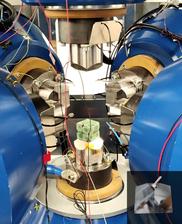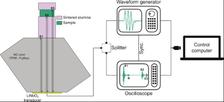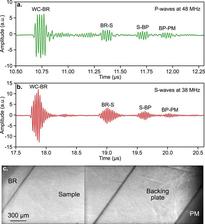High-pressure assembly (with sample surrounded by 8 hard WC anvils, green cube) ready to be compressed in the 'Aster-15' LVP at the PETRA III beamline station P61B. The cables from the assembly connect to the ultrasonic transducer on the bottom anvil (see inset for detail) to measure the wave speeds, and to the thermocouple to measure the temperature. (Photo: Adrien Néri, Univ. Bayreuth)
Probing the Earth’s interior is a difficult task. Direct access to depths greater than 12 km in the crust – so far only reached by the Kola Superdeep borehole – is not nearly enough to reach the mantle below the continental crust. To understand plate tectonic processes, such as earthquakes, knowledge of rocks down to 700 km is required. Notwithstanding, experiments under extreme pressure and temperature conditions can create almost identical conditions as in the Earth’s interior and can help to gain deeper insights into the effects that are important to us on Earth.
In a joint collaboration between DESY and the University of Bayreuth, a permanent ultrasonic system was installed and a novel dual travel time method was developed. It allows the measurement of elastic wave velocities (seismic velocities), under extreme pressure and temperature conditions. Together, the team from the PETRA III beamline station P61B and the Bayerisches Geoinstitut successfully calibrated this system using the most abundant mineral ‘olivine’ from the upper part of the Earth’s mantle. The first results of this unique combination of an ultrasonic system with synchrotron radiation for in-situ measurements in the Large Volume Press (LVP) ‘Aster-15’, have been published in the journal Reviews of Scientific Instruments.
Interest in the experimental setup is twofold: on one hand, experimentalists collect and test candidate materials, such as minerals, under conditions of high pressure and high temperature and measure their elastic properties. On the other hand, seismologists collect large amounts of seismic data from earthquakes and explosions, which depend on the physical properties of the material the seismic waves pass through. Joint efforts, by looking at how fast an ultrasonic wave (20 – 70 MHz) travels in a material under the simulated conditions and how a seismic wave (1 – 100 Hz) reflects and refracts through the structure in the Earth, help us to explain the Earth’s interior. It should be noted that in-situ X-ray diffraction can also provide a constraint on the compressional (bulk modulus) properties of materials under high pressure and temperature, whereas the shear modulus can only be measured from the elastic wave velocities.
The ultrasonic system, installed at the PETRA III beamline station P61B, consists of a waveform generator and an oscilloscope. By emitting electric sine-wave signals through a piezoelectric transducer, the system captures echoes to determine two-way travel time of elastic waves through the sample in a high-pressure cell assembly. By utilizing X-ray radiography to measure sample length in-situ, and X-ray diffraction for density measurements, researchers can calculate elastic moduli and their pressure derivatives. Tests on (Fe,Mg)2SiO4 olivine samples produced high-quality data, and comparisons with reported single-crystal Brillouin literature data revealed an outstanding agreement with conventional measurements.
This hints at the potential for developing an internal pressure standard in laboratories without access to synchrotron X-rays. However, the innovative combined setup at PETRA III can lead to further in-depth insights to interpret the seismic structure of our planet’s interior, as well as other planetary bodies.
Reference:
A. Néri, L. Man, J. Chantel, R. Farla, G. Bauer, S. Linhardt, T. Boffa Ballaran, D. J. Frost, The development of internal pressure standards for in-house elastic wave velocity measurements in multi-anvil presses, Rev. Sci. Instrum. (2024); DOI: 10.1063/5.0169260









